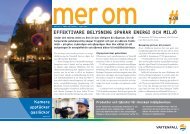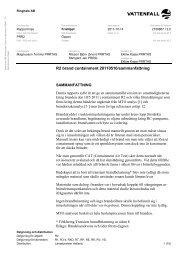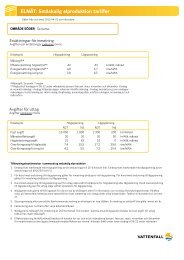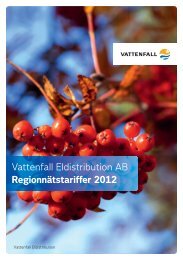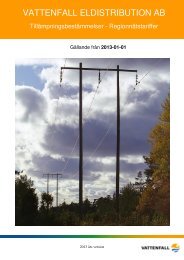This environmental impact assessment for Kriegers flak ... - Vattenfall
This environmental impact assessment for Kriegers flak ... - Vattenfall
This environmental impact assessment for Kriegers flak ... - Vattenfall
Create successful ePaper yourself
Turn your PDF publications into a flip-book with our unique Google optimized e-Paper software.
96 PRESENTATION OF THE AREA<br />
d) Survey by radar<br />
Radar observations from a surveying ship at Krieger<br />
Flak were carried out during 88 nights and days<br />
between April 2002 and March 2004. The survey was<br />
carried out with ship radar directed vertically towards<br />
the sky with a reach of 1 500 metres.<br />
Generally, the highest intensity of the night ß ight<br />
occurred during the months of April/May and September/October.<br />
ekon*h-1*km-1 ekon*h-1*km-1<br />
19:e April<br />
1:a May<br />
sommar<br />
sommar<br />
16:e July<br />
1:a August<br />
1:a September<br />
1. undersökningsår (2002/2003)<br />
2. undersökningsår (2003/2004)<br />
1:a October<br />
1:a November<br />
21:a February<br />
1:a March<br />
mum number of recorded echoes was <strong>for</strong> the night<br />
ß ight 2 967 echoes per hour and km, and <strong>for</strong> the day<br />
ß ight, 1 355 echoes per hour and km.<br />
vinter<br />
vinter<br />
Those ß ights recorded by radar, were concentrated<br />
to a few days and nights where the ß ight intensity was<br />
greater at nighttimes. Half of the spring ß ights were<br />
recorded during four days and half of the autumn<br />
ß ights during two days. During the summer months of<br />
July/August and during March, hardly any ß ights took<br />
place at night, se table below.<br />
The average number of birds migrating at night was<br />
considerably higher than during daytime. The maxi-<br />
19:e April<br />
1:a May<br />
16:e July<br />
1:a August<br />
Distribution<br />
Flyttsträckets<br />
between<br />
fördelning<br />
day and<br />
day<br />
night<br />
och<br />
flights<br />
night mel-<br />
in the period<br />
between<br />
lan<br />
April<br />
April<br />
2002<br />
2002<br />
and<br />
och<br />
March<br />
March<br />
2004<br />
2004<br />
Year of research Year 2 Year 1<br />
Night Day Night Day<br />
sommar<br />
sommar<br />
1:a September<br />
1. undersökningsår (2002/2003)<br />
2. undersökningsår (2003/2004)<br />
Average +/- SA (ekon*h-1 *km-1 ) 147±330 25±76 241±357 117±132<br />
Median (ekon*h-1 *km-1 ) 12 3 89 73<br />
Min./max. (ekon*h-1 *km-1 ) 0/2.967 0/804 0/2.131 0/1.355<br />
n original echos 17.229 4.334 15.024 13.869<br />
n corrected echos 144.240 36.549 181.491 137.399<br />
number of nights/days 48 49 37 39<br />
The characteristic values of the flight intensity (echoes *h-1*km-1) according to radar<br />
data; comparison of day and night flights (SA = standard deviation)<br />
ekon*h-1*km-1 ekon*h-1*km-1<br />
1:a October<br />
1:a November<br />
vinter<br />
vinter<br />
21:a February<br />
1:a March<br />
A comparison of the maximum migration intensity<br />
at <strong>Kriegers</strong> Flak with that recorded at Falsterbo shows<br />
that the highest migration intensity is 0.3 – 0.4 times





